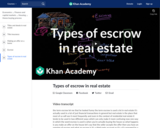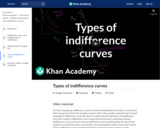
Why yields go down when prices go up. Created by Sal Khan.
- Subject:
- Economics
- Social Science
- Material Type:
- Lesson
- Provider:
- Khan Academy
- Provider Set:
- Khan Academy
- Author:
- Sal Khan
- Date Added:
- 07/15/2021

Why yields go down when prices go up. Created by Sal Khan.

Short Description:
Social media, digital devices, and networked communication systems have become fully integrated into our everyday living experience. This e-book touches upon the human experience of contemporary trends that affect how we perceive ourselves, others, and society.
Long Description:
Authored as a companion to COMM601 Trends in Digital & Social Media, Granite State College (USNH), Concord, NH.
Word Count: 25859
(Note: This resource's metadata has been created automatically by reformatting and/or combining the information that the author initially provided as part of a bulk import process.)

That all men are created equal” is a high and mighty concept, but far from the reality of Virginia in the 18th century. How do we reconcile a body of law that does not live up to our highest ideals?

This activity aims to stimulate discussion on the question of whether computers can exhibit Ňintelligence" or are ever likely to do so in the future. Learners play a game and try to distinguish between a human and a computer by asking questions and analyzing the answers. This game is similar to the Turing Test, founded by British mathematician Alan Turing. Variations, extensions, background information and further reading suggestions are included in the PDF.

In this video from Wide Angle, visit a makeshift night school in rural India designed to allow child laborers who work during the day to obtain an education.

A list of 25 landmark cases in the history of the Supremem Court of the United States of America

In order to show the world that the completed Brooklyn Bridge was strong enough, P.T. Barnum and his twenty-one elephants parade across to prove to everyone that the bridge is safe. The resource includes a lesson plan/book card, a design challenge, and copy of a design thinking journal that provide guidance on using the book to inspire students' curiosity for design thinking. Maker Challenge: Build a bridge between two tables or chairs that will hold one elephant per student in the class. Each student designs their own “elephant” using materials in the classroom.
A document is included in the resources folder that lists the complete standards-alignment for this book activity.

In this lesson, students will explore the views of the founders concerning the relationship between Church and State. They will examine quotes from the founders regarding the relationship of Church and State, as well as analyze excerpts from primary source documents concerning this relationship.

On May 25, 1787, the fifty-five delegates to the Constitutional Convention began meeting in a room, no bigger than a large schoolroom, in Philadelphia’s State House. They posted sentries at the doors and windows to keep their "secrets from flying out." They barred the press and public, and took a vow not to reveal to anyone the words spoken there. There were speeches of two, three, and four hours. The convention, which lasted four months, took only a single eleven-day break. Explore these primary sources to learn more.

In imperfect competition, firms have some control over the price they charge, so the individual firm's demand curve is not horizontal. Learn how that fact also changes the marginal revenue curve in this video.

In real estate transactions there are typically several kinds of escrow accounts. Explore some of th different escrow real estate accounts in this video.

Indifference curves for normal goods, substitutes and perfect complements. Created by Sal Khan.

Students will explore U.S. census data to see the spatial differences in the United States' population.
GeoInquiries are designed to be fast and easy-to-use instructional resources that incorporate advanced web mapping technology. Each 15-minute activity in a collection is intended to be presented by the instructor from a single computer/projector classroom arrangement. No installation, fees, or logins are necessary to use these materials and software.

This webpage includes information about the amendments to the U.S. Constitution.

On September 25, 1789, Congress transmitted to the state Legislatures twelve proposed amendments to the Constitution. Numbers three through twelve were adopted by the states to become the United States (U.S.) Bill of Rights, effective December 15, 1791.

This Census Bureau page contains frequently updated stories in the form of short blog-style posts. Each story highlights a unique demographic topic and is supported by data and visuals. Use these as part of whole group instruction, or design small-group activities with America Counts to get students doing geography.

The Census Bureau publishes a number of interactive maps that allow students and teachers to explore up-to-date census data, as well as historical data, migration patterns, and many other demographic topics. Use this page as inspiration for both whole-group and small-group activities.

US Census Bureau International Database houses key demograhpic data for most countries in the world. Data can be displayed numberically in tables, or graphically as population pyramids and line graphs.

Part of the Census. Bureau Interactive Maps collection, this Census Flows Mapper is worth highlighting on its own. Use it with students to allow exploration of internal migration patterns of United states.

The Quick Facts page allows teachers to access, explore, and compare basic Census data at multiple scales. As an example, compare Census data in the same table for the U.S.A (national scale), your state (sub-national scale), and your county or city (local scale). This data can be used to frame lessons on demographic patterns. Explore the data available and use what interests you and your students. This data can help develop several of the Foundational Geography Skills, as well as the Guiding Questions, found in the UEN standards document.